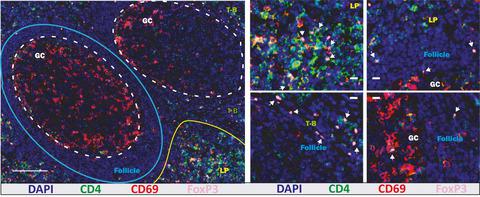当前位置:
X-MOL 学术
›
Immunol. Cell Biol.
›
论文详情
Our official English website, www.x-mol.net, welcomes your feedback! (Note: you will need to create a separate account there.)
Tissue-resident regulatory T cells accumulate at human barrier lymphoid organs
Immunology and Cell Biology ( IF 4 ) Pub Date : 2021-06-03 , DOI: 10.1111/imcb.12481 Rehana V. Hewavisenti 1, 2 , Angela L. Ferguson 1, 2, 3 , Georgia Gasparini 1 , Tomoki Ohashi 1 , Asolina Braun 4 , Thomas S. Watkins 5 , John J. Miles 5 , Michael Elliott 6, 7 , Frederic Sierro 1, 8 , Carl G Feng 1, 2, 3 , Warwick J Britton 2, 6 , Thomas Gebhardt 4 , Stuart Tangye 9, 10 , Umaimainthan Palendira 1, 2, 3
Immunology and Cell Biology ( IF 4 ) Pub Date : 2021-06-03 , DOI: 10.1111/imcb.12481 Rehana V. Hewavisenti 1, 2 , Angela L. Ferguson 1, 2, 3 , Georgia Gasparini 1 , Tomoki Ohashi 1 , Asolina Braun 4 , Thomas S. Watkins 5 , John J. Miles 5 , Michael Elliott 6, 7 , Frederic Sierro 1, 8 , Carl G Feng 1, 2, 3 , Warwick J Britton 2, 6 , Thomas Gebhardt 4 , Stuart Tangye 9, 10 , Umaimainthan Palendira 1, 2, 3
Affiliation

|
Regulatory T cells (Tregs) play a critical role in immune regulation and peripheral tolerance. While different types of Tregs have been identified in both mice and humans, much of our understanding about how these cells maintain immune homeostasis is derived from animal models. In this study, we examined two distinct human lymphoid organs to understand how repeated exposure to infections at the mucosal surface influences the phenotype and tissue localization of Tregs. We show that while Tregs in both tonsils and spleen express a tissue-resident phenotype, they accumulate in greater numbers in tonsils. Tonsillar-resident Tregs exhibit a highly suppressive phenotype with significantly increased expression of CD39, ICOS and CTLA-4 compared with their counterparts in circulation or in the spleen. Functionally, resident Tregs are able effectively to suppress T cell proliferation. We further demonstrate that tonsillar-resident Tregs share key features of T follicular helper cells. Spatial analysis reveals that the vast majority of resident Tregs are localized at the border of the T-zone and B cell follicle, as well as within the lymphocyte pockets enriched with resident memory T cells. Together our findings suggest that resident Tregs are strategically co-localized to maintain immune homeostasis at sites of recurrent inflammation.
中文翻译:

组织驻留调节性 T 细胞在人体屏障淋巴器官中积累
调节性 T 细胞 (Tregs) 在免疫调节和外周耐受中起关键作用。虽然已经在小鼠和人类中发现了不同类型的 Treg,但我们对这些细胞如何维持免疫稳态的大部分理解来自动物模型。在这项研究中,我们检查了两个不同的人类淋巴器官,以了解反复接触粘膜表面的感染如何影响 Treg 的表型和组织定位。我们表明,虽然扁桃体和脾脏中的 Tregs 表达组织驻留表型,但它们在扁桃体中积累的数量更多。扁桃体驻留的 Treg 表现出高度抑制的表型,与循环或脾脏中的对应 Treg 相比,CD39、ICOS 和 CTLA-4 的表达显着增加。在功能上,常驻 Tregs 能够有效抑制 T 细胞增殖。我们进一步证明扁桃体驻留的 Tregs 具有 T 滤泡辅助细胞的关键特征。空间分析表明,绝大多数常驻 Treg 位于 T 区和 B 细胞滤泡的边界,以及富含常驻记忆 T 细胞的淋巴细胞袋内。总之,我们的研究结果表明,常驻 Treg 具有策略性的共定位,以在复发性炎症部位维持免疫稳态。以及在富含常驻记忆 T 细胞的淋巴细胞袋中。总之,我们的研究结果表明,常驻 Treg 具有策略性的共定位,以在复发性炎症部位维持免疫稳态。以及在富含常驻记忆 T 细胞的淋巴细胞袋中。总之,我们的研究结果表明,常驻 Treg 具有策略性的共定位,以在复发性炎症部位维持免疫稳态。
更新日期:2021-06-03
中文翻译:

组织驻留调节性 T 细胞在人体屏障淋巴器官中积累
调节性 T 细胞 (Tregs) 在免疫调节和外周耐受中起关键作用。虽然已经在小鼠和人类中发现了不同类型的 Treg,但我们对这些细胞如何维持免疫稳态的大部分理解来自动物模型。在这项研究中,我们检查了两个不同的人类淋巴器官,以了解反复接触粘膜表面的感染如何影响 Treg 的表型和组织定位。我们表明,虽然扁桃体和脾脏中的 Tregs 表达组织驻留表型,但它们在扁桃体中积累的数量更多。扁桃体驻留的 Treg 表现出高度抑制的表型,与循环或脾脏中的对应 Treg 相比,CD39、ICOS 和 CTLA-4 的表达显着增加。在功能上,常驻 Tregs 能够有效抑制 T 细胞增殖。我们进一步证明扁桃体驻留的 Tregs 具有 T 滤泡辅助细胞的关键特征。空间分析表明,绝大多数常驻 Treg 位于 T 区和 B 细胞滤泡的边界,以及富含常驻记忆 T 细胞的淋巴细胞袋内。总之,我们的研究结果表明,常驻 Treg 具有策略性的共定位,以在复发性炎症部位维持免疫稳态。以及在富含常驻记忆 T 细胞的淋巴细胞袋中。总之,我们的研究结果表明,常驻 Treg 具有策略性的共定位,以在复发性炎症部位维持免疫稳态。以及在富含常驻记忆 T 细胞的淋巴细胞袋中。总之,我们的研究结果表明,常驻 Treg 具有策略性的共定位,以在复发性炎症部位维持免疫稳态。



























 京公网安备 11010802027423号
京公网安备 11010802027423号